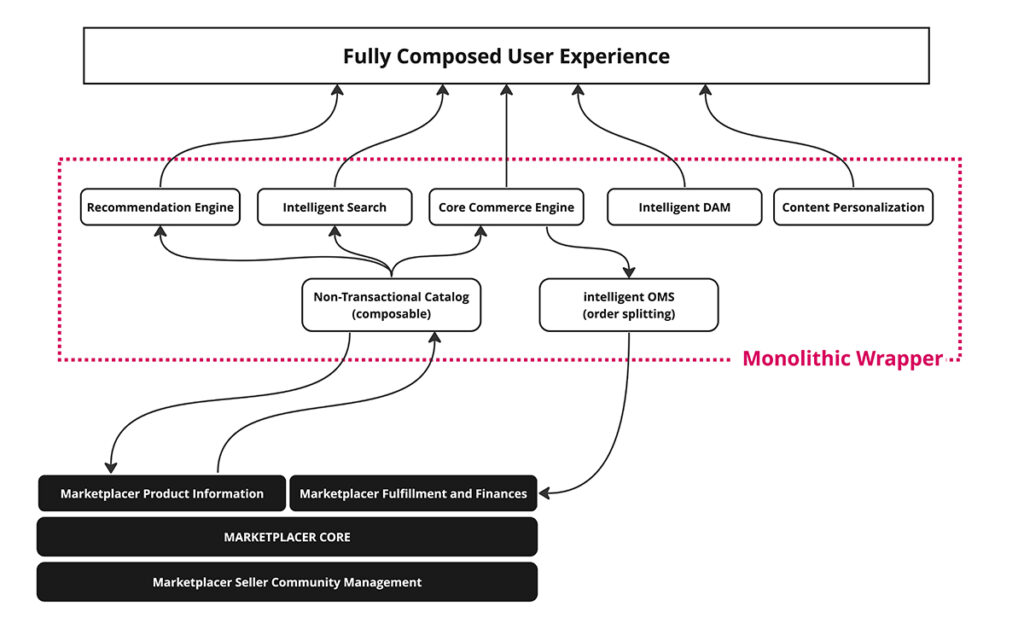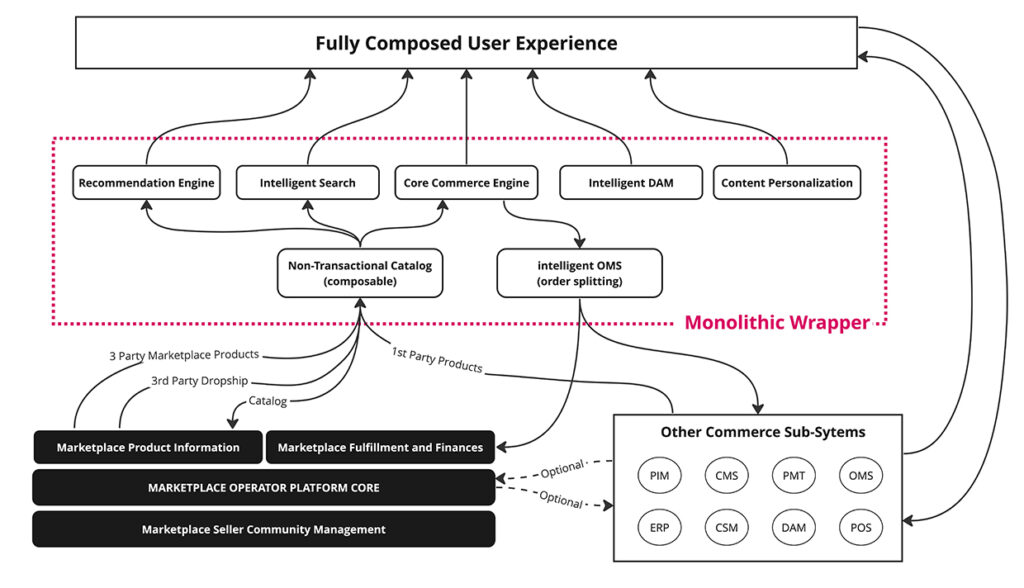Marketplacer and Composable Commerce
Composable commerce has been in-market for a few years now, mostly due to a publication by Gartner in 2020 referring to a modular digital commerce approach defined as a composable architecture. While some might say it is a rebranding of a concept called Service Oriented Architecture (SOA) popularized in the 2000s, there is no arguing that it has morphed into one of the hottest topics in the world of eCommerce solution strategy options. So let’s explore how Marketplacer fits into a Composable Commerce Strategy.
If we ask the all-knowing oracle called ChatGPT what composable commerce is, below are the first two paragraphs of the result:
Composable commerce refers to a modern approach to e-commerce architecture that allows businesses to customize their online commerce platform by integrating individual, best-of-breed components, services, and microservices. This approach enables businesses to create a personalized and flexible commerce experience that meets the specific needs of their customers rather than relying on a rigid, one-size-fits-all platform.
The components of a composable commerce architecture include various commerce-related functionalities, such as payment processing, order management, inventory management, product information management, customer service, and marketing automation. Businesses can select and integrate the components that best fit their requirements, and the components can be easily swapped or upgraded as business needs change over time. Interestingly, ChatGPT also took the words composable commerce and returned the answer in the context of a specific architecture, placing it as a technical consideration. In later blog articles, I will explore the business side of composable, but for now, we will stick with the technical side.
It is also interesting to see the references to “best-of-breed” and “components.” Marketplacer is a best-of-breed platform that can service a variety of the components or services that an organization needs to be effective at adding 3rd party product selling into their existing digital commerce experiences. This means that Marketplacer sits slightly below the choice of Composable Architecture, which is sometimes referred to as a “build” style solution,” versus a Monolithic Architecture, which is often thought of as a “buy” style solution. One can take our APIs and UI elements and use the services that make the most sense to their use cases/business processes regardless of an organization’s preferred approach.

The diagram above shows a set of functional core commerce areas serviced by more than one vendor or system in a Composable Architecture. In contrast, the Monolithic Architecture would put all those components inside their wrapper as a single holistic solution. The Composable Architecture approach means each service or component can be adjusted, modified, and scaled independently, while the Monolith needs to do these things as a group. In both cases, the Marketplacer offering would sit below the Core Commerce Architecture regardless of the chosen approach, acting as a set of accessible sub-components or services that the comerce core relies on to fully activate the desired user experience.
In most cases, there will also be some additional sub-systems that sit outside the core commerce architecture. Depending on the capabilities and purpose of each sub-system, they could be composed directly into the user experience, serving the core commerce architecture, or be accessed directly by another sub-system, such as Marketplacer.

When thinking of how these sub-systems interact with each other or the core commerce system, there are two primary integration strategies/methods. They are PUSH and PULL. Neither Composable nor Monolithic architecture explicitly declares that one is more preferred. This is a different discussion that is based on the relative merits of an event-driven architecture. Composable does expressly state that it is based on integrations with multiple vendors/services. Each organization likely needs a mix of integration patterns to allow the strategy to encompass all elements of a viable digital commerce user experience, their specific ecosystem, and each sub-system’s technical capabilities.
It is worth pointing out that Marketplacer supports PUSH and PULL data patterns. We offer a powerful webhooks event-driven PUSH module to augment the traditional PULL/POST-based API pattern. This becomes increasingly important as we expanded the illustration to include some of the other systems that would typically be part of the overall ecosystem and that Marketplacer would need to communicate with to provide our full value when selling and settling transactions that involve 3rd party products. For example, Marketplacer helps ensure that as soon as an order is placed, accepted, or shipped from a 3rd party seller, our event-driven webhooks can notify critical systems like customer service and email/sms platforms to ensure that all are in alignment and that the end customer receives a first-class experience. We aim to fit our solution into your overall ecosystem as it sits today.
Marketplacer also offers a variety of accelerators designed to help connect to Monolithic and Composable focused core commerce platforms as well as to a wide variety of other sub-systems and business partners. This help to lower the risk and speed up time to value when one or more of those systems are present in our customer’s technical ecosystem.
In summary, yes Marketplacer comfortably fits into a composable commerce strategy due to the fact that it is fundamentally a layer below the direct participants in the composition of specific user experiences. We also fit into a Monolithic strategy and all points in between. So chat with us (insert link) and see what we can do to help you grow regardless of your preference.





